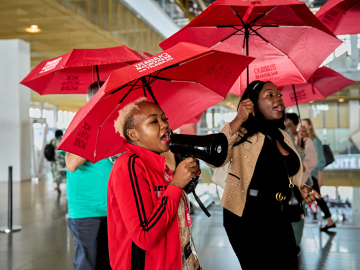A Single Bracelet Does Not Jingle
The Democratic Republic of the Congo has a chance to save millions of children with an inexpensive grassroots community effort
In the Democratic Republic of the Congo (DRC), a country beleaguered by years of civil war, official corruption and mismanagement, and civil apathy, the path to building a strong health system is challenging. One initiative, focused on building up community-level care, has shown success—but without more support from the Congolese government, it might not continue.
The USAID-funded Integrated Health Project (IHP) aims to increase the availability of health services for the most vulnerable people in the country, which has one of the world’s highest rates of child mortality (the top killers include malaria, diarrhea, and pneumonia). IHP has focused on interventions ranging from simple—handwashing, breastfeeding—to more complex, such as tuberculosis care, financial management, medication distribution, etc.
Of all the IHP interventions, however, we have found that the single most cost-effective and effective is a volunteer community health worker initiative called “integrated community case management.” But after its initial 5-year run, IHP is coming to a close. And if the Congolese government doesn’t make its own investments to leverage the important efforts already under way, the lives of countless children will be at risk.
A focus on community
In DRC, when people who live in remote rural areas fall ill with one of these preventable and treatable diseases, they often have to walk to the nearest health facility, which may be several miles away. Many—especially children—don’t survive the journey.
So we turned to the widely accepted best practice of integrated community case management, which harnesses the strong sense of community that exists in these villages, to solve seemingly intractable problems.
In villages where the closest facility was several miles away, we recruited 2 volunteer residents and trained them as community health workers. These volunteers were trained by a chief nurse in a health facility, who then supervised them with periodic visits to the village. They learned how to recognize signs of common diseases, triage patients for care, and dispense the correct medications. They obtained the drugs from the health facilities and brought them back to their homes, which became the village’s community care site.
It took a while for residents to gain confidence in these convenient care sites, which now number 776. At first, we only treated 924 episodes of malaria. 2 years later, the number rose 30,000. In 5 years, these sites treated more than 60,000 children for the mosquito-borne illness.
The beauty of this model is that it taps into people’s natural desire to help their neighbors. In a recent blog post, Deen L. Garba of the Center for Strategic and International Studies’ Global Health Policy Center wrote, “To solve Nigeria’s rampant TB problem, everyday Nigerians, health workers, and government agencies must harness their shared devotion to community...If government can match the commitment exhibited by health workers at the grassroots level with the appropriate financing and resources, then Nigeria can finally begin to get a handle on TB.”
The impact of the IHP community interventions has stretched beyond the realm of children’s health. Village residents have tackled issues including nutrition for moms and children (using local crops and promoting breastfeeding), sanitation (fixing water wells and installing latrines), and infrastructure (pooling funds to build health facilities).
A promising start
Since its launch in 2010, IHP contributed to the availability of health services for more than 800,000 people living in hard-to-reach villages—among them 160,000 children under 5. By the end of the project, the community case management sites were responsible for treating more than 418,000 new cases of childhood illness (malaria, pneumonia, and diarrhea).
Despite the dire needs of the Congolese people, there are signs of progress. In response to a global call for action that brought ministers of health, finance, and development together in Washington, DC in 2012 to reduce maternal, child, and neonatal mortality, the Congolese government committed to saving the lives of 430,000 children under 5 and some 7,900 mothers by 2015 under the banner of UNICEF’s “A Promise Renewed.”
The country’s budget allocation for health has also increased, from 3.5% in 2011 to 8.6% in 2015. This is still far less than what the Abuja declaration recommends for all African countries (at least 15% of a country’s annual budget should be allocated to improve the health sector). Plans for increased health infrastructure have started, with an aggressive target to build and equip 1,200 health facilities over 5 years.
The country is also helping to finance vaccine costs, not just using what it receives through foreign assistance. And the government has made good on its promise to match contributions made by the Global Fund to Fight AIDS, Tuberculosis and Malaria.
But none of these government efforts are benefiting the community case management model. Of the 1,200 planned health facilities, none will be associated with a community case management site. And the health expenditures are not earmarked for medications or incentives for the community health workers.
Until that commitment is made, the health of some of DRC’s most vulnerable people will continue to rely on international donors. If everyone involved in building the country’s health system doesn’t get serious about these promising community efforts, moms and kids will perish first and, as a result, the rest of the country will suffer.
Ousmane Faye is the project director of the Integrated Health Project (IHP), funded by USAID and implemented by Management Sciences for Health and other partners. IHP aims to increase access to and availability of high-impact health services, products, and practices in the Democratic Republic of the Congo.
Join the thousands of subscribers who rely on Global Health NOW summaries and exclusive articles for the latest public health news. Sign up for our free weekday enewsletter, and please share the link with friends and colleagues: Subscribe to GH
Josephine Ilunga (left), a community health worker, with a young mother and her baby in Tshifumba, DRC. Photo: Landry-Serges Malaba, Management Sciences for Health




